
A Purdue University specialist is the lead author of the new Purdue Cooperative Extension Service publication The Selection and Inspection of Hoses: An Integral Component of Everyday Equipment. The nearly 50-page guide — Extension publication PPP-89 — covers hose-related topics, including choosing the right hose for the job, cutting and installation, inspection and maintenance, hose reels, and proper disposal.
September 14, 2010

Thought about the hoses connected to your farm equipment? If not, you should, a Purdue University specialist advises.
Hoses are an important part of agricultural machinery, said Fred Whitford, coordinator of Purdue Pesticide Programs. If they break or leak they can create expensive chemical spills or injuries.
"Hoses are like the arteries of the equipment," he said. "You can have a $200,000 sprayer or million-dollar piece of machinery but, ultimately, the hoses allow fluids — whether oil, hydraulics or chemicals — to function."
Wealth of information
Whitford is the lead author of the new Purdue Cooperative Extension Service publication The Selection and Inspection of Hoses: An Integral Component of Everyday Equipment. The nearly 50-page guide — Extension publication PPP-89 — covers hose-related topics, including choosing the right hose for the job, cutting and installation, inspection and maintenance, hose reels, and proper disposal.
While written for an agricultural audience, the publication also applies to other industries. A print copy is available for $5 from Purdue's The Education Store at https://mdc.itap.purdue.edu/item.asp?item_number=PPP-89 or it can be downloaded free.
Although hoses generally are made from plastic or rubber compounds, they usually serve specific purposes, Whitford said.
"A hose is not designed to carry every fluid available," he said. "If you're using anhydrous ammonia, it's going to take a different material to hold that chemical versus a pesticide, fertilizer or water. The hose has to be built to stand different pressures."
Along with the types of chemicals the hose will carry and under what pressure levels, Whitford said buyers should consider the following when selecting a hose:
• What is the hose diameter?
• How much hose length do I need?
• Will the hose have to bend or flex?
• Will the hose contact petroleum products?
• Will the hose stay outdoors?
•What physical equipment will the hose be in?
• Will the hose's weight be an issue?
• What type of hose clamps and fittings are needed?
• What will the hose cost?
"We shouldn't go into a store and say, 'I need an 8-foot rubber hose,'" Whitford said. "What we should say is something like, 'I need an 8-foot rubber hose that's going to carry fertilizer, be dragged on the ground, that needs a cover and is going to be under this pressure.' We want to give the person behind the counter something to go by."
Regular inspection and replacement of worn-out hoses can prevent costly accidents. About 25 percent of chemical spills and leaks Whitford said he has witnessed involved faulty hoses.
"It does take time to check hoses. But if we think about the consequences of a hose breaking, we could be talking about thousands of dollars in cleanup and possible lawsuits," he said.
The Selection and Inspection of Hosescontains a wealth of photographs and diagrams.
In addition to Whitford, seven others contributed toward the publication's production, including land-grant university specialists and farm equipment and hose manufacturing professionals.
You May Also Like



